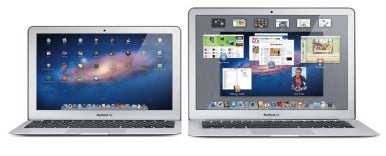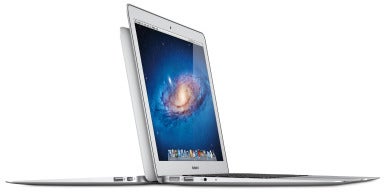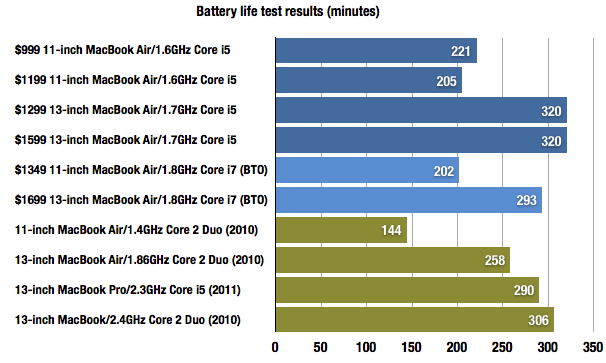
If the MacBook Air is the future of the Mac laptop, the future is now.
Don't mess with success
The physical design of these new MacBook Air models is exactly the same as the ones introduced in October 2010: They're anodized aluminum on the outside, with glossy LED-backlit displays framed by an aluminum bezel. People who hate the glass-covered screens on the MacBook Pros should note that not all glossy screens are alike. I've found the MacBook Air's style of glossy screen to be less prone to glare than the MacBook Pros. (Unlike the MacBook Pro models, which feature a single slab of glass across the entire front of the display, the MacBook Air continues to feature an ultra-thin glass layer located behind the bezel, making it less prone to glare.) Like every other Mac laptop, there’s a tiny FaceTime camera located immediately above the display, though the Air's cameras aren't capable of the HD resolution offered by the cameras on the MacBook Pros and iMacs.These laptops are wedge shaped, thin at the front and thicker at the back. There's no room for an optical drive or a traditional hard drive—the only onboard storage uses flash memory. At the thick end of the wedge, there's room enough for a few ports: on the left side there's a single USB 2 port, a headphone jack, and a MagSafe power socket. On the right side, there's another USB 2 port, an SD card reader (on the 13-inch model only), and taking the space of the Mini DisplayPort is the new Thunderbolt port.
The only real physical change to the exterior versus previous models comes with the keyboard, which is now backlit. I've always considered this feature more luxury than essential, but it's certainly nice to have it back, especially if you tend to work on your laptop in the dark. Both models are also slightly heavier—the 11- and 13-inch models weigh 20 and 30 grams more (the difference of an ounce, more or less), respectively.
Apple was wise not to change the design: this is a pretty great pair of laptops. The 11.6-inch model in particular is fantastic—it's the smallest Apple laptop of all time and yet remains perfectly usable, with a full-size keyboard and a 1366-by-768-pixel display. The 13-inch model, on the other hand, feels spacious in comparison, while being dramatically thinner and lighter than the 13-inch MacBook Pro.
Beauty and brains

The 13-inch MacBook Air even holds its own with the $1199 Core i5 13-inch MacBook Pro. Our tests found that the new Air was on average 1.4x as fast in that same set of tests, though much of that was buoyed by the increased speed of the Air's flash storage versus the slower physical hard drive on the Pro. In the processor-dominated HandBrake test, the Pro model was 1.1x as fast as the Air. Factor storage and processor together, and it seems safe to say that the two models are comparable.
The news on the 11-inch front is even brighter: The new $999 11-inch Air, powered by a 1.6GHz Core i5 processor, was 1.7x as fast as the previous $999 model on the same set of processor- and storage-focused tests. Our HandBrake encode test was 2.4x as fast. As someone who uses the previous-model 11-inch MacBook Air regularly, I never really felt it was too slow for my daily work... yet this new model is measurably faster in almost every respect.
One way the Core i5 chips manage to be faster than Core 2 Duos at the same speed is because the Core i5 and i7 have access to two clever Intel tricks: Hyper-threading and Turbo Boost. Hyper-threading means that while these chips have two processor cores, they appear to the operating system as if they've got four cores. This trick allows the processor to run more efficiently when it comes to heavy-duty number crunching. In many ways, Turbo Boost produces the opposite effect: When only one processor core is being tasked, the chip can shut down one core and crank up its clock speed, allowing it to run inefficient software at higher speeds than an older chip could.
There is one respect, however, in which these MacBook Airs are a regression from last year's model. Apple's done to the MacBook Airs what it did with the 13-inch MacBook Pro earlier this year: replace the previous generation's graphics processor—in this case, the Nvidia GeForce 320M—with Intel HD Graphics 3000 integrated graphic circuitry. The performance of the 2011 MacBook Air's graphics subsystem was all over the map.
When we tested the Airs using our tried-and-true graphics tests—Cinebench's OpenGL test and a Call of Duty demo—the performance was poor. Frame rates on the new models were 65 to 70 percent of what they were on the 2010-model Airs. (The 13-inch MacBook Pro with integrated graphics posted similarly bad scores.) When we asked Apple about what we were seeing, the company suggested the possiblity that newer games would be more properly optimized for this relatively new subsystem.
So we did a new round of testing, this time with Valve's Portal 2, a cutting-edge game released in April. And sure enough, the results were much better: the current-year MacBook Airs were capable of producing frame rates slightly faster than the previous-generation models.
The lesson here seems to be that while graphics performance on recent software releases will be comparable to the previous generation of MacBook Air models, graphics-intensive apps such as games that haven't been updated to address the Air's new graphics systems will be slow.

These results are an average of 13 of our tests: Duplicate folder, Zip folder, Unzip file, Pages import, iMovie import, iTunes share, iTunes encode, Handbrake encode, Cinebench OpenGL, Cinebench CPU, Call of Duty, Portal 2, and Parallels WorldBench Multitask.
Batteries and heat
Apple claims that these MacBooks have roughly the same battery capacity as previous models. The company rates the 11-inch model for five hours of use via its "wireless web" test suite; the 13-inch model rates at seven hours. Macworld Lab's battery tests, which are designed to drain the battery even more rapidly than Apple's tests, still showed similar results: roughly three-and-a-half hours for the 11-inch model and five-and-a-half hours for the 13-inch. Those figures were both improvements on the battery life of the previous-model Airs. (The increased speed of the build-to-order Core i7 processor option didn't have a major impact on battery life, either.)
Battery test results. Our battery tests play a movie looping in full-screen mode at full brightness, connected to a Wi-Fi network, with the backlit keyboard dimmed, and volume on 2.
When the processors do crank up, the fans do, too. And they're not silent, at least not when they're running full blast. Again, in most use cases these laptops are cool and quiet—but if you decide you need to run Final Cut Pro X and export an HD movie to iTunes, noise and warmth are what you're gonna get.
No longer isolated
When the MacBook Air first arrived on the scene, it only had one wired connection to the outside world: a single USB 2 port. At one point I had a seven-port hub at my desk so that I could connect Ethernet, trackball, keyboard, iPhone, and external storage to my Air. (It was very, very slow.) Last year's Air redesign added a second USB port, which helped, but the Air was still awfully limited compared to any other Mac out there.The addition of the Thunderbolt port changes everything. Yes, it's compatible: you can still plug in any Mini DisplayPort cable and the laptop will display video on an external display just fine. But Thunderbolt is so much more than that. It's a connection technology vastly superior not just to USB, but to FireWire and eSATA as well. Fast hard-drive transfers, gigabit Ethernet, FireWire compatibility—all of these features are now just a Thunderbolt adapter or three away from being available to MacBook Air users. (The catch is that Thunderbolt is a technology in its infancy, so there's not much Thunderbolt stuff out there now. But it's coming.)
Take Apple's just-announced 27-inch Thunderbolt display. It's got a Facetime HD camera, three USB 2.0 ports, a FireWire 800 port, a Gigabit Ethernet port, and a Thunderbolt port on the back. Plug its Thunderbolt cable into one of these new MacBook Air models, and you've converted that laptop into a Core i5-powered desktop computer complete with fast network connection, fast storage, and an array of expansion ports. For laptop users who also work at a desk, it's a pretty compelling vision.
Factory upgrades aplenty
If the four base configurations of the MacBook Air don't please you, Apple has provided a few upgrade options. The processor and RAM in these systems aren't upgradeable, so you'll need to decide before you buy if you want them.Both the 11-inch and 13-inch models can be upgraded to an even faster processor: a 1.8GHz Core i7. It's a $150 and $100 upgrade, respectively. These systems are limited to a maximum of 4GB of RAM; all but the $999 model come stocked with that amount by default, while it's a $100 upgrade option for the low-end model. We tested these build-to-order (BTO) configurations in late July and found them faster, although subtly so. The 11-inch upgrade definitely seems to make a more substantial difference than the 13-inch upgrade.
These editions all use flash storage for their hard drives. The $999 model has 64GB, the $1199 and $1399 models offer 128GB, and the $1,599 model comes with 256GB. If you prefer the 11-inch configuration, you can upgrade the flash storage on the high-end model to 256GB for an extra $300.
Flash storage is one area where there's some competition when it comes to upgrades. Other World Computing offers the Mercury Aura Pro Express flash storage upgrade at sizes up to 480GB. They're not cheap—if you just want 256GB you're better off going with Apple's factory upgrade—but they're available if money's no object and you need as much flash storage as possible.
MacBook Air (mid-2011) configurations
| 11-inch | 11-inch | 13-inch | 13-inch | |
|---|---|---|---|---|
| Price | $999 | $1199 | $1299 | $1599 |
| Processor | 1.6GHz Core i5 | 1.6GHz Core i5 | 1.7GHz Core i5 | 1.7GHz Core i5 |
| Memory | 2GB | 4GB | 4GB | 4GB |
| Flash storage | 64GB | 128GB | 128GB | 256GB |
| Shared video memory | 256MB | 384MB | 384MB | 384MB |
| Processor upgrade option | none | 1.8GHz Core i7, $150 | none | 1.8GHz core i7, $100 |
| Memory upgrade option | 4GB, $100 | none | none | none |
| Storage upgrade option | none | 256GB, $300 | none | none |
Lion recovery mode
These MacBook Air models were announced simultaneously with the release of OS X Lion. As a result, they only run under Lion—if you're committed to Snow Leopard or running PowerPC-based apps, you shouldn't get one.But by being among the first systems in the Lion era, these MacBook Airs also have a major advantage over previous models: they can restore themselves after a catastrophic drive failure. It's all a part of the Lion Recovery feature, enabled by holding down Command-R when booting. If the main volume is corrupted, Lion Recovery will attempt to boot a small hidden recovery partition, from which the disk can be repaired or erased and restored. That's a feature available on any system running Lion. These new systems, though, can even restore if the disk is completely wiped out. They contain within them the ability to boot, connect to the Internet, download Lion from Apple, and restore it to a replacement or external hard drive. I didn't get a chance to try this feature with the MacBook Airs—though my colleague Dan Frakes managed to do it with a Mac mini—but it's pretty cool to know that as long as you've got an Internet connection, wiping your drive and starting afresh is a legitimate option.
Judging the 13-inch Air
If you're someone who needs as much laptop screen space as possible, the MacBook Air line isn't for you. (At least not yet—I think it's inevitable that Apple will make a 15-inch laptop with many of the Air's characteristics in the near future.) But if you can get by with a 13-inch screen, I think the MacBook Air is a better choice than the MacBook Pro.There are always exceptions. If you need an optical drive and don't have access to another Mac for that function, you may not want to buy an Air and then pay more for an external drive. If you absolutely must pay the least amount possible for a 13-inch Mac laptop, you can save $100 on the 13-inch MacBook Pro. The $1499 Core i7 edition of the 13-inch MacBook Pro is faster than the 13-inch Air. The MacBook Pro has more storage space, owing to its spinning hard drive. If you're a serious gamer, you'll want a laptop with discrete graphics.
But Apple has built the MacBook Air for what it believes is the sweet spot of the laptop market: people who are over the optical disc, who don't need any more processing power than an Intel Core i5 processor can provide, and who don't need massive amounts of disk space (or at least don't need to carry it all with them). These people want a small, light laptop, and the MacBook Air provides.
Judging the 11-inch Air
Now let me make my case for the 11-inch MacBook Air. It's shockingly small, almost iPad small. It makes the 13-inch Air seem overly large and heavy, and the MacBook Pros seem like boat anchors.But while the 11-inch Air is small and light, it doesn’t feel cramped. Part of that is due to the high-resolution display, which packs a lot of pixels into its compact 11.6-inch diagonal screen. Throw in Lion's Mission Control and full-screen mode, which are designed to help maximize productivity on small screens, and even this tiny Mac is capable of large amounts of productivity.
Is the 11-inch Air slower than Apple's other laptops? Sure. It's also, at $999, cheaper. And its Core i5 processor makes it fast enough for almost any regular user. If you’re using the Web, writing e-mail or articles or novels, and other relatively lightweight tasks, the MacBook Air is plenty fast. Even building web graphics in Photoshop was fast. Now, if you’re planning on using it to edit multitrack audio or complex HD video projects, you may find yourself pushing its limits. But most people will not attempt to use an 11-inch laptop for such things, and rightly so.
Macworld's buying advice
The MacBook Air has never been a laptop for everyone. It began as a niche laptop for a tiny sliver of the population, but in the intervening three years there's been a sea change. Today, most people in the market for a Mac laptop should seriously consider the MacBook Air. Sure, there are some people for whom it's a poor fit—but I suspect they are increasingly the exception, not the rule. (There's a reason Apple's marketing slogan for this version of the Air is "The ultimate everyday notebook.")At just a hair below three pounds, the 13-inch MacBook Air will probably hit the sweet spot for users accustomed to larger computer screens. But for my money, the 11-inch Air is the real winner here. At $999, it's now holding down the low-price end of the Apple laptop market. It will almost certainly be the laptop of choice for students, and they'll love its light weight and small size.
Then upgrade it to an i7 processor with 4GB of RAM and a 256GB hard drive, attach it to an external display and peripherals via its Thunderbolt port, and you've got a tiny system with an amazing amount of power. The 11-inch MacBook Air might not be the perfect computer, but it's as close to perfect as Apple's ever come.









0 comments:
Post a Comment